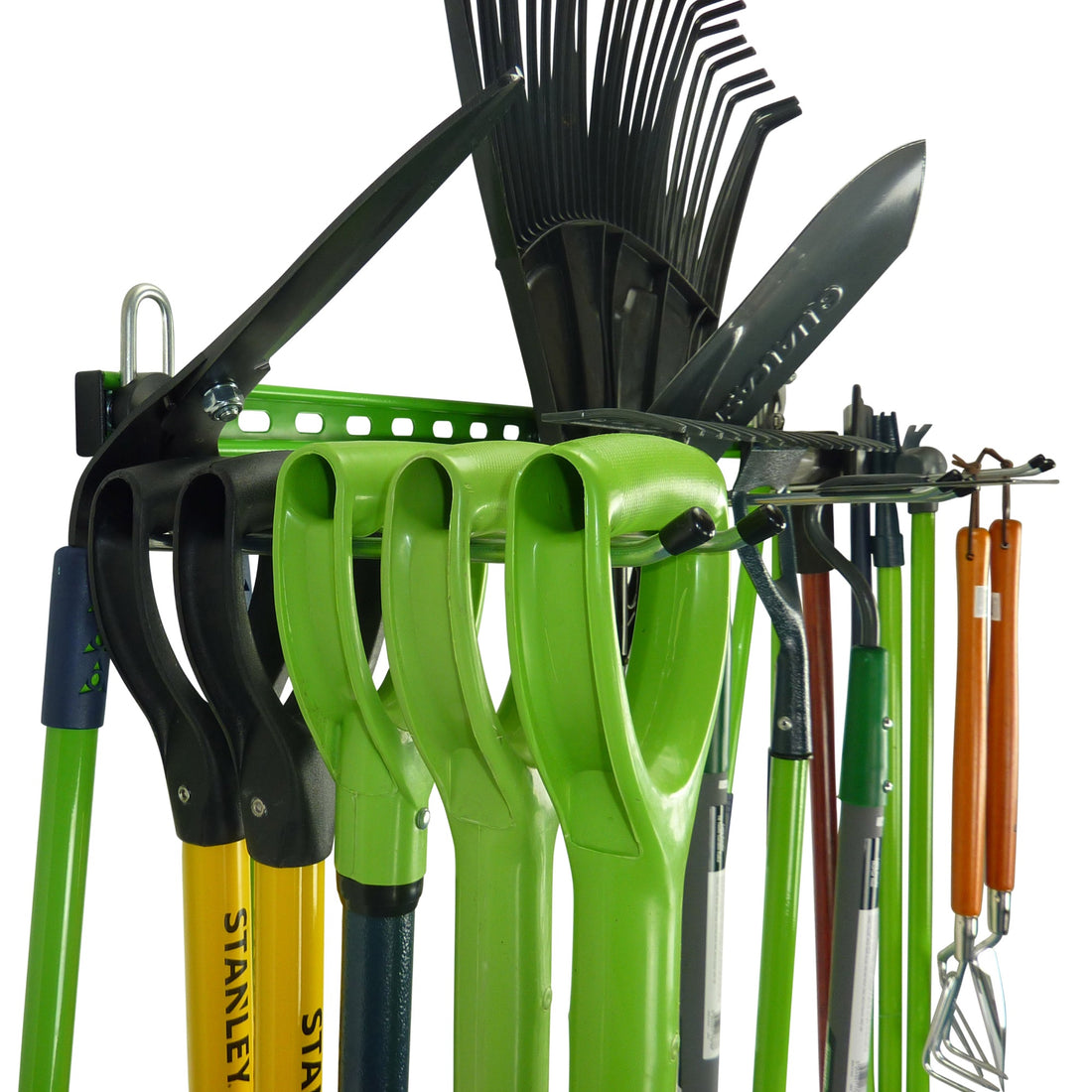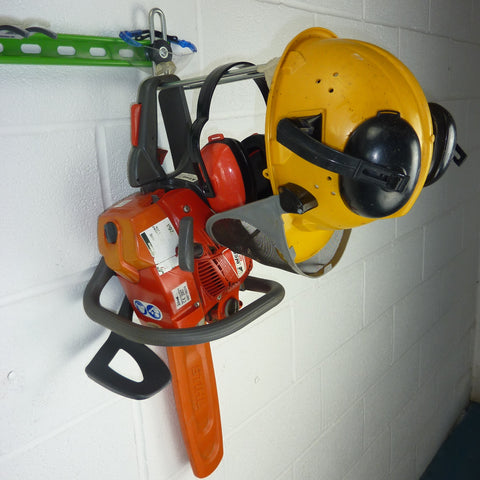
Garden Tool Storage for Professionals
Share
Introduction
A professional storage solution for gardening and landscaping tools is critical for many professionals like Landscape Gardeners, Grounds Keepers and Head Gardeners, Facilities Managers, Construction and Landscaping Contractors, Local Councils and Parks Maintenance Staff.
A pile of tools in the corner or a row of 6" nails banged into the wall isn't going to cut the mustard!
Professional gardeners work with a wide range of tools, both handheld and large-scale equipment, and having easy access to them can greatly improve efficiency and productivity.
This article will explore the importance of professional garden tool storage and provide valuable tips and strategies on how to create an effective storage system.
The GearHooks Approach
GearHooks are the leading designers and manufacturers of Professional Garden Tool Storage Racks in the UK. They are designed to hold a large number of tools in the minimum space whilst allowing them to be easily organised and quickly accessed.
A typical rack comprises a 1 metre long galvanised AND powder coated steel rail which is bolted to the wall with just 3 heavy duty wall bolts. Once that is fitted, 3 or 5 tool hooks can be fixed to the rail in any position using just an Allen Key.
Each galvanised steel hook is 300mm long and comprises two prongs. Lots of tools can be hung over or between the prongs such as up to 8 spades, shovels, forks, rakes brooms and other tools. The big benefit of this is that tools are stored several deep making the most of the available wall space. A typical rack can hold around 30 or 40 tools. The ones used the most often naturally migrate to the front of the rack.
This approach allows 5 - 10 times as many tools to be stored on every metre of wall space compared to individual tool hooks or wire tool racks which fill up the wall really quickly. That's vital if you are storing tools in a limited space.
The hooks are strong enough to allow several heavier items like sledge hammers, mauls and axes to be stored on one hook. Petrol or battery powered tools like chain saws, hedge trimmers, strimmers and even lawn mowers can also be hung up with ease.
The Importance of Professional Garden Tool Storage
A GearHooks rack holding a chain saw
Professional gardeners deal with a vast array of tools, ranging from shovels and rakes to hedge trimmers and chainsaws. Without proper storage, these tools can easily get damaged, misplaced, or lost, causing unnecessary expenses and delays in work.
A well-designed professional garden tool storage system offers numerous benefits:
- Protection: One of the primary advantages of professional garden tool storage is the protection it provides to your valuable tools. Weather elements, such as rain, snow, and sunlight, can cause significant damage to your tools if left exposed. Proper storage ensures that your tools remain safe and shielded from these harsh conditions. Additionally, a secure storage system reduces the risk of accidental damage or theft.
- Easy Access: An organized storage system allows professional gardeners to have easy access to their tools. When tools are neatly arranged and clearly labeled, it becomes effortless to identify and retrieve the required tool quickly. This saves a significant amount of time that would otherwise be wasted searching for specific tools, enabling gardeners to complete tasks more efficiently.
- Extended Lifespan: Professional garden tools can be expensive, and their proper maintenance is essential to ensure their longevity. By storing tools correctly, you can prevent rusting, dulling, or deterioration, thus prolonging their lifespan. When tools are well-maintained and stored properly, they remain in optimal condition, perform effectively, and last longer.
- Improved Efficiency: Professional garden tool storage plays a vital role in enhancing overall efficiency. A clutter-free storage system eliminates the time wasted on searching for tools and allows gardeners to focus more on their tasks. When tools are organized and accessible, it streamlines the workflow, leading to increased productivity.
- Enhanced Safety: Professional garden tools can pose safety hazards if not stored properly. When tools are scattered or left unattended, they become trip and fall hazards. Additionally, sharp tools that are not stored securely can cause injuries. By implementing a professional storage system, you can ensure the safety of both yourself and others working in the garden.
Tips for Creating an Effective Professional Garden Tool Storage System
A GearHooks rack holding heavy items like a maul, sledge hammer and axes
1. Evaluate Your Tools
Begin by evaluating your collection of tools. Take inventory and identify the different types of tools you use regularly. Categorize them based on their function and size. This evaluation will help you determine the specific storage requirements for each type of tool.
2. Choose the Right Storage Solution
Invest in high-quality storage solutions that are specifically designed for professional garden tools. Consider options such as tool sheds, cabinets, wall-mounted racks, pegboards, and tool chests. Select solutions that provide adequate protection, organization, and accessibility for your tools. It is important to choose storage solutions that can withstand the weather conditions of your region.
3. Organize by Function and Size
When storing your tools, organize them based on their function and size. This systematic approach makes it easier to locate specific tools when needed. For example, keep all digging tools together, all cutting tools together, and so on. Additionally, store larger equipment in a separate area to prevent them from cluttering the storage space.
4. Utilize Vertical Space
Make the most of the available vertical space by using wall-mounted racks, pegboards, or hooks. Utilizing vertical storage not only saves valuable floor space but also allows you to display your tools in an organized and easily accessible manner. By having your tools in plain sight, you can quickly identify and retrieve the tool you need without any hassle.
5. Label and Arrange
Label the storage compartments or containers to indicate the type of tool stored within. This simple step can significantly contribute to maintaining an organized storage system. When you label each storage area, you can quickly identify the tool you need at a glance, saving time and effort. Furthermore, arrange your tools in a consistent order to ensure the overall neatness and efficiency of the storage system.
6. Consider Climate Control
If you live in an area with extreme weather conditions, consider climate-controlled storage options for your professional garden tools. Extreme temperatures, humidity, and moisture can damage your tools over time. Climate-controlled storage helps to maintain proper temperature and humidity levels, ensuring that your tools remain in optimal condition.
7. Regular Maintenance
Regular maintenance is key to maximizing the lifespan of your professional garden tools. Inspect and clean your tools on a regular basis, removing any dirt, debris, or rust. Lubricate any moving parts as necessary. Proper maintenance not only extends the lifespan of your tools but also ensures that they are always ready for use.
8. Security Measures
When it comes to professional garden tool storage, security is paramount. Consider implementing security measures such as locks, surveillance systems, or even a gated enclosure to protect your valuable tools from theft. Additionally, ensure that your storage area is well-lit and easily accessible during working hours, while also remaining secure when unattended.
9. Regular Audit and Upgrades
Regularly assess and evaluate your professional garden tool storage system. Conduct audits to identify any areas that need improvement or modification. As your tool collection grows or changes, consider upgrading your storage solutions to accommodate the evolving needs of your profession. Adapting and upgrading your storage system ensures that it continues to function optimally.
Conclusion
Professional garden tool storage is a vital aspect of every professional gardener's routine. By implementing an effective and well-organized storage system, you protect your tools, save time, improve efficiency, and ensure the longevity of your equipment. Evaluate your storage needs, invest in appropriate storage solutions, maintain a well-organized space, and follow regular maintenance practices. Remember, a well-cared-for tool is a gardener's best friend. With a professional garden tool storage system in place, you can focus more on what you love - creating and maintaining beautiful gardens.
To see the full range of GearHooks Professional Garden Tool Storage Racks click here.
Further Reading
What do we mean by Professional Gardeners?
Gardening tools are used by a variety of professionals in various fields, in addition to hobbyist gardeners. Here are some professionals who use gardening tools as part of their work:
-
Landscape Architects: Landscape architects design and plan outdoor spaces, including gardens and parks. They use gardening tools to implement their designs and maintain landscaped areas.
-
Gardeners: Professional gardeners specialize in caring for and maintaining gardens. They use a wide range of gardening tools to plant, prune, weed, and nurture plants and landscapes.
-
Arborists: Arborists are tree care professionals who use specialized tools, such as pruning shears and climbing gear, to maintain and manage trees in urban and natural environments.
-
Groundskeepers: Groundskeepers are responsible for maintaining the landscaping of public or private properties, including parks, sports fields, golf courses, and corporate campuses. They use gardening tools for mowing, pruning, and general maintenance.
-
Horticulturists: Horticulturists are experts in plant science. They use gardening tools to conduct research, cultivate plants, and manage botanical gardens or nurseries.
-
Farmers: While not traditional gardeners, farmers use various agricultural tools, some of which overlap with gardening tools, for planting, tilling, and harvesting crops.
-
Greenhouse Workers: Professionals working in greenhouses use gardening tools to care for and propagate plants in controlled environments.
-
Parks and Recreation Staff: Employees responsible for maintaining public parks, recreational facilities, and community gardens use gardening tools for upkeep and beautification.
-
Facility Managers: Facility managers at educational institutions, corporate campuses, and large residential complexes may use gardening tools to maintain the landscaping on their properties.
-
Botanists: Botanists, who study plant biology, may use gardening tools for fieldwork, plant collection, and research.
-
Urban Planners: Urban planners and designers incorporate green spaces into urban environments and may use gardening tools to plan and maintain these spaces.
-
Grounds Maintenance Crews: Crews responsible for maintaining the grounds of universities, hospitals, and other institutions use gardening tools for landscaping and upkeep.
-
Pest Control Professionals: Pest control experts often use gardening tools to apply pesticides or herbicides to manage plant-related pests and diseases.
-
Environmental Conservationists: Conservationists working to restore natural habitats and ecosystems may use gardening tools in native plant restoration projects.
-
Florists: Florists use gardening tools for cutting, arranging, and preserving flowers and foliage for floral arrangements.
-
School Gardening Instructors: Educators who teach gardening in schools use gardening tools to introduce students to horticulture and outdoor education.
-
Volunteers and Community Garden Organizers: People involved in community gardens and volunteer initiatives use gardening tools to cultivate and maintain shared garden spaces.
-
Construction and Landscaping Contractors: Contractors involved in landscaping projects often use gardening tools for site preparation, planting, and finishing touches.
These professionals use gardening tools as part of their daily work to create, maintain, and manage outdoor spaces, plants, and landscapes, each with their specific expertise and objectives.
What kind of tools are we talking about?
The types of hand tools that can be stored on a GearHooks Garden Tool Rack include:
-
Digging Tools:
- Shovel: Used for digging holes, moving soil, and transplanting.
- Garden Spade: Smaller than a shovel, ideal for precise digging and transplanting.
- Garden Fork: Used for turning and aerating soil and compost.
- Mattock: Combines a pick and an adze for breaking up hard soil.
-
Cultivating Tools:
- Hoe: Used for weeding and cultivating the soil's surface.
- Hand Cultivator: A handheld tool with prongs for loosening soil and weeding.
- Cultivator Tiller: Powered tool for tilling and cultivating larger areas.
-
Cutting and Pruning Tools:
- Pruning Shears (Secateurs): For trimming and shaping small branches and stems.
- Loppers: Similar to pruning shears but with longer handles for thicker branches.
- Pruning Saw: Designed for cutting through thicker branches and limbs.
- Hedge Shears: Used for trimming and shaping hedges and shrubs.
-
Planting Tools:
- Garden Trowel: A small hand tool for planting, transplanting, and weeding.
- Bulb Planter: Designed to create holes for planting bulbs at the correct depth.
- Dibber: Used for making holes in soil for planting seeds or young plants.
-
Raking and Levelling Tools:
- Rake: Ideal for leveling soil, gathering leaves, and spreading mulch.
- Leaf Rake: Designed specifically for collecting leaves and debris.
- Soil Rake: Used for leveling and preparing soil for planting.
- Broom: for sweeping areas
Weeding Tools:
- Weeder: Designed specifically for removing weeds from the root.
- Weed Puller: A tool for removing weeds by their roots with minimal effort.
Power Tools can also be stored on the GearHooks heavy duty hooks, such as:
-
Lawn Mower:
- Use: Lawn mowers are used to cut grass to a uniform height. They come in various types, including push mowers, self-propelled mowers, and riding mowers (although these cannot be hung up!!), suitable for different lawn sizes.
-
String Trimmer (Strimmer):
- Use: String trimmers are used for cutting grass and weeds in areas that are difficult to reach with a lawn mower, such as edges along fences, sidewalks, and flower beds.
-
Leaf Blower:
- Use: Leaf blowers are used to gather and move leaves, grass clippings, and debris from driveways, walkways, and lawns. They come in gas, electric, and battery-powered models.
-
Hedge Trimmer:
- Use: Hedge trimmers are used to shape and maintain hedges and shrubs. They can create clean, precise cuts for a neat appearance.
-
Chainsaw:
- Use: Chainsaws are used for cutting and pruning trees, branches, and logs. They come in various sizes and types, suitable for different tree-cutting tasks.
-
Brush Cutter:
- Use: Brush cutters are heavy-duty tools used for clearing dense vegetation, tall grass, and brush in overgrown areas. They are often used for land clearing and trail maintenance.
-
Tiller/Cultivator:
- Use: Tillers and cultivators are used to prepare garden beds by breaking up and tilling the soil. They come in various sizes, from small handheld models to larger tractor-mounted versions.
-
Chippers and Shredders:
- Use: Chippers and shredders are used to process branches and garden waste into mulch or compost. Chippers are for larger branches, while shredders handle smaller plant debris.
-
Pressure Washer:
- Use: Pressure washers use high-pressure water streams to clean surfaces like decks, driveways, and garden furniture. They are also useful for removing moss and mildew.
-
Rototiller:
- Use: Rototillers are larger, heavy-duty machines used for deep soil cultivation, turning over large garden plots, and preparing soil for planting.
-
Lawn Edger:
- Use: Lawn edgers are used to create clean edges along sidewalks, driveways, and garden beds, giving lawns a manicured appearance.
-
Aerators:
- Use: Lawn aerators are used to perforate the soil with holes, improving air and water penetration for healthier grass growth.
-
Dethatcher/Scarifier:
- Use: Dethatchers or scarifiers remove thatch (accumulated dead grass and debris) from lawns, promoting better grass health and growth.
-
Cordless Pruning Shears:
- Use: Cordless pruning shears are powered handheld tools used for cutting small branches and stems. They are ideal for quick pruning and deadheading.
-
Electric Garden Shredder:
- Use: Electric garden shredders are used to shred plant material and create compostable mulch. They are quieter and more suitable for smaller tasks compared to larger chippers.
-
Pole Saw:
- Use: Pole saws have a long, extendable pole with a chainsaw or pruner head. They are used for trimming high branches and tree limbs without a ladder.
-
Lawn Sweeper:
- Use: Lawn sweepers are used to collect leaves, grass clippings, and debris from lawns and driveways, depositing them in a collection bag.
-
Electric Auger:
- Use: Electric augers are used for digging holes in the ground for planting trees, shrubs, and fence posts. They are faster and more efficient than manual post hole diggers.
If you need any help or advice when thinking about which tools can be stored on a GearHooks rack please get in touch.



